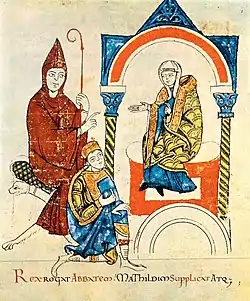Hugh of Cluny
Hugh (13 May 1024 – 28 April 1109), sometimes called Hugh the Great or Hugh of Semur, was the Abbot of Cluny from 1049 until his death. He was one of the most influential leaders of the monastic orders from the Middle Ages.
Saint Hugh of Cluny | |
|---|---|
 Hugh of Cluny, Henry IV, Holy Roman Emperor, and Matilda of Tuscany | |
| Born | 1024 Semur-en-Brionnais, Brionnais (now Saône-et-Loire), France |
| Died | 28 April 1109 Cluny, Brionnais (now Saône-et-Loire), France |
| Venerated in | Roman Catholic Church |
| Canonized | 6 January 1120 by Pope Callixtus II |
| Feast | 29 April |
| Patronage | Against fever |
Biography

Hugh was the son of Count Dalmas I of Semur and Aremberge of Vergy;[1] his father wanted him to be a knight and a secular leader. At the age of fifteen, he took his monastic vows, and later became an abbot.[2] Abbot Hugh built the third abbey church at Cluny, the largest structure in Europe for many centuries, with funds provided by Ferdinand I of León. He was the driving force behind the Cluniac monastic movement during the last quarter of the 11th century, which had priories throughout Southern France and northern Spain.
Political influence
Hugh's relationship to Ferdinand I and Alphonso VI of León and Castile, including the release of Alphonso from his brother, Sancho's prison.[3] His influence upon Pope Urban II, who had been prior at Cluny under Hugh, made Hugh one of the most powerful and influential figures of the late 11th century.
As the godfather of the Holy Roman Emperor, Henry IV, he also played a role as a mediator during the conflict between Pope Gregory VII and Henry IV, though he was not successful. Additionally, he was an active diplomat to Germany and Hungary on behalf of the church. He died the 28th of April, 1109. Many of his relics were pillaged or destroyed by the Huguenots in 1575.
After Clementia of Burgundy was married, she gifted Hugh the Flemish monastery of St. Bertin.[4] This act spread the Cluniac order north of the Loire and initiated monastic reform in Flanders.[4]
His feast day is April 29.
References
- Iogna-Prat 2002, p. 90.
- Bouchard 1987, p. 49.
- Bouchard 1987, p. 145.
- Bouchard 1987, p. 146.
Sources
- Bouchard, Constance Brittain (1987). Sword, Miter, and Cloister:Nobility and Church in Burgundy, 980-1198. Cornell University Press.CS1 maint: ref=harv (link)
- Iogna-Prat, Dominique (2002). Order & Exclusion: Cluny and Christendom Face Heresy, Judaism, and Islam. Cornell University Press.CS1 maint: ref=harv (link)
External links
- Catholic Encyclopedia: St. Hugh the Great